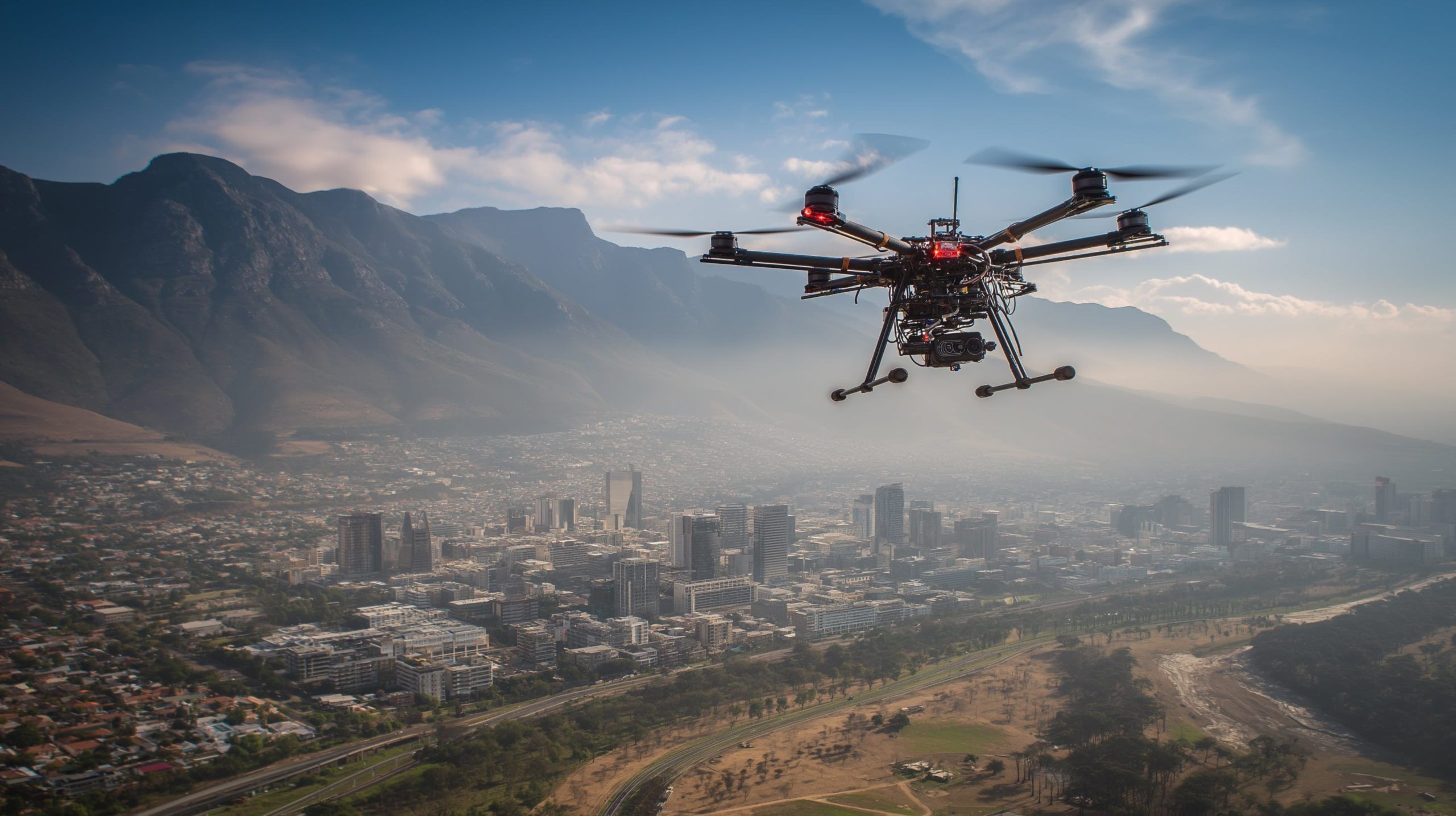- The South African Civil Aviation Authority (SACAA) regulates drones under Part 101 of the Civil Aviation Regulations, which came into force on 1 July 2015.
- The 2023 amendments renamed the Remote Pilot Licence to Remote Pilot Certificate and updated related terminology, while core licensing requirements remained largely the same.
- The legal maximum altitude is 120 meters above ground level, with recreational pilots typically advised to stay under 50 meters unless explicitly authorized.
- Drones may not fly within 10 kilometers of any airport or airfield without SACAA approval and coordination with air traffic control.
- All operations must be conducted in Visual Line of Sight, with Beyond Visual Line of Sight flights allowed only by rare case-by-case approval.
- National parks are no-fly zones for private drones in South Africa, as enforced by SANParks.
- Night flying is generally prohibited and requires a specific waiver or ROC authorization; daytime flying is the default.
- Registration is mandatory for all non-toy drones, requiring a Certificate of Registration and, for commercial operations, a Remote Pilot Certificate, plus an ROC and a Remotely Piloted Aircraft Letter of Authority valid for 12 months for each drone model.
- Enforcement includes penalties of up to 10 years’ imprisonment or a fine of R50,000 for Civil Aviation Regulations violations, with the SACAA and SAPS empowered to suspend licenses or revoke approvals.
- Commercial drone operators must also obtain an Air Service Licence (ASL) and an ROC/UASOC, and many firms partner with existing ROC holders due to the complexity.
South Africa has established a comprehensive regulatory framework for the use of unmanned aerial vehicles (UAVs, commonly called drones), balancing innovation with safety and privacy. The South African Civil Aviation Authority (SACAA) is the primary regulator for drones and introduced dedicated drone regulations in July 2015 under Part 101: Remotely Piloted Aircraft Systems of the Civil Aviation Regulations [1]. Since then, the rules have been refined with updates (the latest significant amendments in 2023) to keep pace with technology and international best practices [2]. Key aspects of South African drone law include clear distinctions between recreational versus commercial use, mandatory registration and licensing for commercial operations, strict operational limits (on altitude, airspace, etc.), and hefty penalties for violations. This report provides an up-to-date overview of drone laws in South Africa – including recent changes – and covers special use cases like agricultural drones, delivery trials, and aerial photography. All information is drawn from official and authoritative sources (primarily SACAA guidelines and regulations).
Regulatory Authorities and Legal Framework
SACAA Authority: The SACAA is mandated to regulate all civil aviation activities in South Africa, including drones [3]. Drones are legally classified as Remotely Piloted Aircraft (RPA) under South African law. The core regulations governing drones are found in the Civil Aviation Regulations, 2011 (as amended), notably Part 101 which specifically addresses RPA operations [4]. These regulations have been in force since 1 July 2015 and aim to integrate drones into the national airspace system safely [5]. The regulations are accompanied by Civil Aviation Technical Standards (CATS) that provide additional guidance on technical and operational specifics.
Exclusions (Model and Toy Aircraft): It’s important to note that Part 101 explicitly does not apply to certain types of small hobby aircraft. “Toy” drones (generally small, light drones intended for children or novelty use) and model aircraft used purely for sport or hobby under Part 94 are excluded from Part 101 [6]. In practice, traditional model aircraft flown at clubs under the South African Model Aircraft Association (SAAMA) fall under Part 94 and SAAMA’s oversight, rather than the stricter Part 101 rules [7]. This means casual hobbyists flying at a registered model airfield or with a toy drone have a slightly different legal treatment, though basic safety rules still apply to them. All other drone operations (commercial, corporate, nonprofit, or private use outside the model aircraft realm) are subject to Part 101 [8].
Role of Air Traffic Services: The Air Traffic and Navigation Services (ATNS) and air traffic control units play a key role in ensuring drones do not interfere with manned aircraft operations. Drones are prohibited from flying in controlled airspace or near aerodromes (airports/airfields) without proper authorization [9]. Specifically, no drone may be flown within 10 km of any airport or airfield unless approved by the SACAA (which would involve coordination with air traffic control) [10]. This rule is to prevent conflicts with passenger aircraft. SACAA directives also state that a drone pilot must yield right-of-way to all manned aircraft and not endanger their safety [11]. In practice, if a drone operator needs to fly in controlled airspace (for example, for an inspection near an airport), they must obtain explicit permission and coordinate with ATC/ATNS in advance. Unauthorized drone sightings near airports or in restricted zones can be reported to authorities; both SACAA and law enforcement (SAPS) treat such incidents seriously, and ATC units will log and escalate hazard reports of errant drones [12].
Supporting Laws: In addition to aviation regulations, drone users must comply with other South African laws such as privacy, data protection, and municipal bylaws. For instance, using a drone to record imagery must respect privacy rights – the SACAA explicitly reminds private drone pilots that they “must observe all statutory requirements relating to liability, privacy and any other laws” when flying [13]. Flying a drone in certain locations (e.g. over someone’s home or in a national park) could also invoke laws enforced by other agencies. For example, South African National Parks (SANParks) bans all private drone use over national parks for wildlife protection reasons [14]. Drone pilots are expected to know and obey such overlapping restrictions.
Recreational (Private) vs. Commercial Drone Use
South African law draws a clear line between private (recreational) drone operations and commercial operations. The regulations define private use as the use of a drone “for an individual’s personal and private purposes where there is no commercial outcome, interest or gain” [15]. This essentially covers hobbyist flying – flying for fun, personal photography, or other non-remunerative purposes. In contrast, commercial use of drones refers to any operation where the drone is used for economic gain or in furtherance of business, including services like aerial photography for hire, surveying, deliveries, agriculture services, inspections, or any operation that indirectly or directly earns income [16].
The legal requirements differ substantially for these categories:
- Recreational/Private Operators: Pure hobbyist flyers do not need to obtain a Remote Pilot Licence or register their drones with the SACAA, as long as they stick strictly to personal, non-profit use [17]. Likewise, they do not need an operator certificate or other aviation authority approvals for casual flying. However, they must adhere to all the standard safety rules (discussed later) – e.g. stay under altitude limits, within visual line of sight, away from airports and people. In practice, many private hobbyists operate under the auspices of SAAMA clubs. If a private individual starts to operate outside the hobby realm (for example, flying in ways not allowed under basic hobby rules, or for any kind of remuneration), that individual would lose the hobbyist exemption and be subject to the full Part 101 requirements [18].
- Commercial (and Corporate/Non-profit) Operators: Any drone use that involves compensation, business purposes, or even non-profit organizational use (e.g. NGOs using drones for research or community projects) is treated as commercial under the law [19]. These operations must be fully licensed and approved by the SACAA. At a minimum, the drone itself needs to be registered, and the pilot must hold a valid Remote Pilot Licence (RPL). Commercial entities must also obtain an RPA Operator’s Certificate and, in most cases, an Air Service License, before conducting drone services legally [20]. We detail these requirements in the next section. Because of these requirements, operating commercially is far more complex than flying recreationally.
For clarity, the table below compares the key requirements and limitations for Private vs. Commercial drone use in South Africa:
| Aspect | Private/Recreational Use | Commercial Use (Incl. Corporate/Non-profit) |
|---|---|---|
| Permitted Use | Personal enjoyment, no direct or indirect remuneration (hobby flying only) [21]. | Any operation with commercial outcome or gain (e.g. paid services, business or organizational use) [22]. |
| Drone Registration | Not required for pure private hobby use [23] (model aircraft are exempt from Part 101). | Mandatory – every RPA must have a SACAA Certificate of Registration before operation [24]. Registration involves applying to SACAA with the drone’s details and paying a fee. |
| Remote Pilot License | Not required for hobbyist flying [25]. No pilot certification needed if no commercial intent. | Required – the pilot must hold a valid Remote Pilot Licence (RPL) (also termed Remote Pilot Certificate, RPC, after 2023 amendments) [26]. Obtaining this license entails formal training, exams, and a medical certificate (details below). |
| Operator Certificate | Not applicable. (No need for an operating certificate for personal use.) | Required – the operating entity must hold a UAS/RPAS Operator Certificate (often called ROC or UASOC) issued by SACAA [27] [28]. This is analogous to an airline’s operating license and ensures the company has approved procedures, manuals, and insurance. |
| Air Service License (ASL) | Not applicable for hobby use. | Required if providing drone services to the public or other businesses – an Air Service License from the Air Service Licensing Council is typically needed [29] [30]. (This aligns drones with general aviation commercial air service requirements.) |
| RPAS Letter of Approval | Not required for hobbyists. | Required – Each drone model used commercially should have an RPA Letter of Authority/Approval (RLA) from SACAA [31], certifying the airworthiness or design features if not type-certified. |
| Maximum Altitude | Strongly restricted: Generally advised to stay well below 120 m AGL. Hobby flyers are often cautioned to stay under 50 m (≈150 ft) without special permission [32]. | Up to 120 m (400 ft) AGL allowed in normal operations [33]. (Above 120 m requires specific SACAA authorization.) Even commercial pilots must adhere to altitude limits to avoid other aircraft. |
| Airspace Restrictions | Must stay clear of airports (≥10 km away) and away from any controlled or restricted airspace [34]. No flight in no-fly zones or over crowds. | Same fundamental restrictions – no operations in controlled, restricted, or prohibited airspace without ATC/SACAA permission [35]. Commercial operators can apply for specific airspace approvals case-by-case. |
| Operational Times | Daylight only; no night flying for recreational pilots [36]. | Also generally daylight only. Night operations require a special waiver or part of an approved ROC operations specification. |
| Visual Line of Sight | Must always fly within Visual Line of Sight (VLOS) – i.e., the drone is visible to the naked eye of the pilot at all times [37]. FPV or beyond-line-of-sight not allowed for hobby use. | Also limited to VLOS by default [38]. However, commercial operators can seek approval for Beyond Visual Line of Sight (BVLOS) operations with robust safety cases (rarely granted; see special use cases below). |
| Insurance (Liability) | Not mandated by law for hobbyists (but recommended). | Not explicitly mandated by SACAA for RPA, but an ROC holder usually must have adequate third-party liability insurance as part of their operations manual. Many clients will require insured operators. |
| Enforcement | Recreational flyers are subject to penalties if they endanger others or break airspace rules, but oversight is lighter (enforced by police or SACAA if incidents occur). | Commercial operators are subject to strict oversight and audits by SACAA. Non-compliance can lead to license revocations, fines, or criminal charges. |
Note: The terminology RPL (Remote Pilot Licence) versus RPC (Remote Pilot Certificate) – In 2023, SACAA amended the regulations to rename the RPL as an RPC and updated some licensing provisions [39] [40]. Many publications still use “RPL” interchangeably. Both refer to the required drone pilot license.
Drone Registration and Licensing Procedures
Drone Registration (Certificate of Registration)
Under Part 101, all non-toy drones operated in South Africa must be registered with the SACAA prior to use (with an exception for purely private recreational flying) [41]. Regulation 101.02.4(1) states that “no unmanned aircraft shall be operated within the Republic of South Africa unless such RPA has been issued with a certificate of registration by the Director [of Civil Aviation]” [42]. In practice, SACAA expects every drone used for commercial, corporate or any non-hobby purpose to have a Certificate of Registration (CofR). The drone is assigned a unique registration number (much like a tail number on manned aircraft).
To register a drone, an applicant must submit the required registration form (Form CA-47R1 for new drone registration) along with supporting documents and a fee to the SACAA [43] [44]. If ownership of the drone transfers, the seller and buyer must file change of ownership forms (CA-47R2 and new CA-47R1) within 30 days [45]. The registration process is handled by the SACAA’s Aircraft Registry in Centurion. Upon approval, a Certificate of Registration is issued for the RPA. The registration remains valid as long as the drone remains in service (renewals or deletions are filed if the drone is destroyed, exported, etc.) [46] [47].
For hobbyist pilots, SACAA does not currently require registration of purely recreational drones [48]. Many consumer drones in private use are thus unregistered. However, authorities have raised concerns that the lack of a recreational drone registry makes it harder to trace drones misused in crimes [49] [50]. Future policy might move toward registering even hobby drones. As of 2025, only commercial (or otherwise Part 101) drones must be registered.
Remote Pilot Licensing (RPL/RPC) for Drone Pilots
Any person flying a drone for commercial or other non-recreational purposes in South Africa must hold a Remote Pilot Licence (RPL) – now officially termed Remote Pilot Certificate (RPC) – issued by the SACAA [51]. This is a personal pilot license, analogous to a private pilot license for manned aircraft, but specific to drones. Recreational flyers are exempt from licensing, but the moment you fly for hire or business, you become a “remote pilot” who needs to be licensed.
Eligibility and Training: To qualify for an RPL/RPC, an applicant must: be at least 18 years old, undergo training at an SACAA-approved drone training school, pass a theory examination, pass a practical flight assessment, and obtain a valid medical assessment (at least Class 3 medical for standard operations) [52] [53]. They must also demonstrate English language proficiency (at least ICAO Level 4) and pass a Radiotelephony (RT) exam to ensure they can communicate on aviation radio if needed [54] [55]. The SACAA outlines these requirements clearly, for example:
- Minimum age: 18 years [56]
- Medical certificate: Class 3 aviation medical (for VLOS operations; Class 4 may suffice for some basic ops, but Class 3 is required especially for BVLOS or heavier RPA) [57].
- Training: Complete a course with a certified Approved Training Organisation (ATO) for RPA. The course includes both theoretical knowledge (air law, navigation, meteorology, flight planning, principles of flight, human factors, etc.) and practical flight training on the drone type [58] [59].
- Theoretical exam: Pass the SACAA’s written exams covering the above subjects. (Foreign drone pilot theory certificates can sometimes be validated with SACAA’s approval) [60].
- Practical skills test: Successfully pass a flight test on the drone, administered by an SACAA-designated remote pilot examiner [61]. This test will include normal and emergency maneuvers.
- Radio license: Obtain a Restricted Radiotelephony Certificate to use aviation radios [62].
- English proficiency: Demonstrate English proficiency at level 4 or higher (able to communicate effectively in aviation context) [63].
Once these steps are completed, the training organization will assist in submitting the license application to SACAA, and the pilot is issued an RPL/RPC [64]. The license will specify the category of RPA the pilot is allowed to fly: RPA licenses can be endorsed for Aeroplane (fixed-wing), Helicopter (single-rotor), or Multi-Rotor drone categories [65]. Additional ratings on the license indicate whether the pilot is authorized for only VLOS operations or also Extended VLOS (with observers) or BVLOS operations [66]. Initially, most RPL holders have only VLOS rating by default.
The RPL/RPC is typically valid for 24 months and needs a renewal checkride within that period to remain valid [67] [68]. Pilots must also maintain a logbook of their flight hours and undergo periodic revalidation to ensure competency [69] [70].
Licensing of Foreign Drone Pilots: A foreigner wishing to fly drones in South Africa commercially would also need to obtain an SACAA-issued RPL or have a foreign equivalent license validated by SACAA. There is a process for recognition of prior learning and foreign licenses (for instance, a certified drone pilot from another country or someone with manned aviation experience can get credit toward the South African RPL) [71].
Instructor and Examiner Ratings: Experienced remote pilots can apply for additional ratings to become instructors or examiners. SACAA allows RPL holders to train for a Remote Pilot Instructor rating, and experienced instructors can be designated as Remote Pilot Examiners to conduct flight tests [72]. This helps build local capacity for training new drone pilots.
Operational Certificate (ROC/UASOC) and Air Service Licence for Companies
Beyond pilot licensing, any organization or individual conducting drone operations commercially must obtain certain operational approvals:
- RPAS Operator’s Certificate (ROC/UASOC): This is an authorization for a company (or individual as an enterprise) to conduct specified drone operations. It is similar to an Air Operator’s Certificate for airlines. To get an ROC (also called Unmanned Aircraft System Operator’s Certificate, UASOC), the applicant must develop an operations manual, safety management system, maintenance procedures, and demonstrate to SACAA that they can operate safely. The ROC will list the types of operations allowed (e.g. aerial work, surveillance, etc.), the types of drones to be used, and any special conditions. Commercial, corporate, and non-profit RPAS operations all require an ROC [73] [74] (whereas private recreational operations do not [75]). Gaining an ROC is a rigorous process and can take months – it involves document reviews and practical inspections by SACAA. Many companies opt to partner with existing ROC holders rather than get their own due to the complexity.
- Air Service License (ASL): In South Africa, offering air services to the public (which includes drone services) often requires an Air Service License granted by the Air Service Licensing Council. Part 101 operations are not exempt from this broader legal requirement. Commercial drone operators typically must hold a valid ASL (or work under someone else’s ASL) to be lawful [76] [77]. The ASL ensures the operator meets requirements related to ownership, insurance, and public safety. (There have been complaints in the industry that obtaining an ASL for drones is onerous, especially due to certain corporate requirements such as BEE certification, which small operators find challenging [78].)
- Letter of Approval (RLA) for the Aircraft: The SACAA issues a Remotely Piloted Aircraft Letter of Authority/Approval for each drone model in use commercially. It is essentially a fitness-to-fly approval for non-type-certified aircraft. The RLA is valid for 12 months and must be renewed annually for each RPA, confirming it’s maintained and airworthy [79] [80]. An RLA might involve demonstrating the drone’s specifications, maintenance schedule, and that it meets safety standards.
In summary, a fully compliant commercial drone operation in South Africa needs all of the following: a registered drone, a licensed pilot (RPL/RPC), an ROC for the operation, an RLA for the drone, and (if offering services) an Air Service License [81]. These multiple layers of approval have drawn criticism for being “overly restrictive and burdensome”, especially for small businesses [82]. The process and cost can indeed be prohibitive – requiring aviation medicals, exams, and extensive documentation similar to manned aviation. Industry groups are in dialogue with SACAA to streamline these processes going forward.
Operational Rules and Flight Restrictions
Whether you are a hobby flyer or a licensed commercial operator, South African drone laws impose strict operational rules to ensure safety. Below are the key rules and limitations that drone pilots must follow:
- Maximum Altitude: Drones should not be flown higher than 120 meters (400 feet) above ground level under normal circumstances [83]. This altitude cap is designed to keep drones well below crewed aircraft flight paths. Flying above 120 m requires explicit approval from the SACAA’s Director of Civil Aviation [84]. (Note: recreational flyers are generally advised to stay even lower, e.g. below 50 m (~150 ft), if they do not have any licensure [85], but 120 m is the absolute legal ceiling in most cases.)
- Visual Line-of-Sight (VLOS) Only: All drone operations must be conducted within visual line of sight of the pilot – the remote pilot must be able to see the aircraft with unaided vision at all times [86]. You cannot fly a drone beyond your horizon or behind obstacles such that you lose sight of it. Extended VLOS (using observers) and Beyond VLOS flights are not allowed except by special SACAA approval in specific cases [87]. (Currently, routine BVLOS operations are “reserved for future use” pending new regulations [88].) In short, no flying a drone farther than you can personally see it.
- No-Fly Zones and Airspace Restrictions: It is forbidden to fly in certain airspace or sensitive areas without permission. Key prohibitions include: no flying within 10 km of any aerodrome (airport, airfield, helipad) [89] unless SACAA/ATC has approved; no flying in controlled airspace (the airspace around major airports or flight routes) without clearance [90]; and no flying in restricted or prohibited airspace (areas designated off-limits, e.g. around military bases or critical infrastructure) [91]. Additionally, drones must stay away from manned aircraft – you cannot fly near any airplanes or helicopters; doing so is extremely dangerous and illegal [92]. Certain high-security or sensitive sites are explicitly off-limits to drones. SACAA guidelines list locations such as nuclear power plants, prisons, police stations, crime scenes, courts of law, or national key points/strategic installations as areas where RPA flight is prohibited [93]. Flying over populated public areas (sports stadiums, concerts, public gatherings) is also disallowed for safety and security reasons [94]. National parks are no-fly zones for the public (as per SANParks rules) [95]. Essentially, pilots should only fly in unrestricted airspace well clear of airports, built-up city centers, or sensitive government/private sites.
- Distance from People and Property: Drones may not be flown directly over or within 50 meters (164 ft) of any person, vehicle, building or structure that is not under the control of the drone operator [96] [97]. This is a critical safety rule to prevent injury or property damage. For example, you cannot fly 20 m above a crowd or hover 10 m next to someone’s house without permission. The 50 m standoff distance can be waived only with permission – e.g. if the people in question consent to the operation or if the property owner has given you access. Takeoff and landing also should not be done within 50 m of bystanders. Additionally, flying over public roads or using a road as a takeoff/landing spot is generally prohibited (except for emergency responders in an official operation) [98].
- Daylight-Only Flying:Night flying is not allowed for general drone operations, unless specifically authorized by SACAA. All drones should be flown only during daytime and in clear weather conditions [99]. Pilots should have sufficient visibility to maintain VLOS and avoid hazards. Flying in mist, heavy rain, or cloud that obscures your view of the drone is also prohibited. If a commercial operator wants to do night work (e.g. for security surveillance), they must have night operations included in their ROC and have the required equipment (like anti-collision lights) and approvals.
- Weather and Line-of-Sight: Operations must be in visual meteorological conditions – essentially good weather with adequate visibility. If conditions don’t allow unobstructed visual contact with the RPA (e.g. fog or thick clouds), you may not fly [100]. Also, you cannot intentionally fly into clouds or bad weather. Always inspect your drone before flight and ensure it’s “fit to fly” (pre-flight check of battery, controls, etc. is mandatory) [101].
- No Negligent or Reckless Flying: The regulations contain a general prohibition on careless operation. A drone pilot must not endanger the safety of another aircraft or person (whether through action or omission) [102]. This is a broad rule that can be used to prosecute irresponsible behavior not explicitly covered by another rule. For example, buzzing people or flying in a dangerous manner can lead to penalties even if you weren’t explicitly breaking a distance rule, simply because it’s endangerment. Common-sense safe flying is required at all times.
- No Dropping of Objects / Carrying Hazardous Material: South African rules explicitly prohibit drones from releasing or dropping any objects from the aircraft in flight [103]. Attaching and dropping payloads (whether it’s a package delivery, water balloon, or any substance) is not allowed unless specially approved by SACAA. This means drone delivery of items is not generally permitted under current law (details on delivery in a later section). Likewise, drones are not allowed to carry dangerous goods as cargo (for example, no flying of hazardous chemicals, explosives, etc.) [104]. Any such activities would require case-by-case authority and probably fall under experimental approvals.
- Right-of-Way and Avoiding Aircraft: Drones must always yield to manned aircraft. If an airplane or helicopter is nearby, the drone pilot must maneuver to avoid any possibility of conflict. The law states an RPA should give way and “shall not pass over, under or in front of” a manned aircraft in close proximity [105]. In practice, if you hear or see a low-flying helicopter, you should immediately get your drone on the ground or well clear. Additionally, commercial RPA pilots operating near controlled airspace are required to carry an aviation-band radio to monitor relevant frequencies and make broadcasts of their drone’s position/altitude if needed [106]. This helps in situational awareness for both the drone pilot and other airspace users.
- Miscellaneous Rules: Drones may not tow other aircraft, perform aerobatic maneuvers or formation flying with multiple drones (swarming) without approval [107]. Using a public road for takeoff/landing is forbidden (except by law enforcement or emergency drones in special cases) [108]. Also, the drone must be controlled by only one remote pilot at a time – you cannot have two people simultaneously piloting one drone (handover protocols are needed if control is transferred) [109].
All drone operators should stay updated on Aeronautical Information Circulars (AICs) or notices from SACAA that might impose temporary restrictions – for example, drone no-fly zones around large events or VIP visits can be promulgated. The above rules cover everyday operations.
Enforcement and Penalties
South Africa’s drone regulations are backed by strict penalties for non-compliance. Both the SACAA and South African Police Service (SAPS) are empowered to enforce these laws. Key points about enforcement:
- Criminal Penalties: Violating Civil Aviation Regulations (e.g., flying an unregistered drone commercially, or operating in a no-fly zone, or endangering people) is a criminal offense. Offenders may face up to 10 years imprisonment or a fine of R50,000, or both, upon conviction [110]. This is the upper range; actual penalties would depend on the severity of the breach (for instance, a fatal incident caused by a drone could invoke the maximum, whereas a minor infraction might result in a smaller fine). The possibility of jail time underscores how seriously authorities treat drone safety.
- Administrative Actions: The SACAA can suspend or revoke a Remote Pilot Licence or an Operator’s Certificate if regulations are breached. For example, if a licensed operator flies recklessly, SACAA might pull their license pending investigation. The SACAA has inspectors who conduct oversight and can perform spot checks or investigations of drone operations, similar to how they oversee manned aviation.
- Law Enforcement Involvement: The police (SAPS) work with SACAA to investigate and prosecute illegal drone use, especially if there’s a security component (e.g., drones being used for smuggling or flown in restricted areas). There have been concerns about drones being used in criminal activities, and in response authorities have emphasized improving drone registration and tracking [111] [112]. If you see unauthorized drone activity (say, near an airport or over a concert), it can be reported. SACAA encourages reporting of incidents – for instance, at some sites they use a “Pinky system” or hazard reporting which is then escalated to SACAA and SAPS Air Wing for action [113].
- Civil Liability: Apart from regulatory penalties, drone pilots can face civil lawsuits if their drone injures someone or damages property. Insurance is therefore highly advisable. The operator could be liable under common law for negligence if found to have operated the UAV without due care.
- Compliance Culture: SACAA and legal experts stress that a culture of compliance is needed. The regulations might be tightened in future if people flout the rules. Conversely, good compliance could lead to authorities becoming more flexible over time. The industry message is that responsible behavior now will help the drone sector grow in South Africa by showing that regulations can ensure safety [114] [115].
In summary, flying a drone irresponsibly in South Africa can have serious consequences – from heavy fines to imprisonment. It’s every pilot’s responsibility to know the rules before taking off. Even hobby pilots could be charged for gross negligence if they, say, fly over a busy highway and cause an accident [116]. Thus, education and adherence to the law are paramount.
Recent and Upcoming Regulatory Changes
Drone law is an evolving field, and South Africa is no exception. Since the initial Part 101 regulations in 2015, there have been several updates:
- 2023 Amendments: In 2023, SACAA implemented a set of amendments to the drone regulations (sometimes referred to as the 26th Amendment of the Civil Aviation Regulations). One visible change was terminology updates – for example, the Remote Pilot Licence (RPL) is now called the Remote Pilot Certificate (RPC) in the regulations [117] [118]. Likewise, designations like “Designated Flight Examiner (DFE)” for drones were renamed “Designated Remote Examiner (DRE)”. These changes were mostly semantic, aiming to harmonize terms. The licensing requirements (age, medical, etc.) remained largely the same, though wording was adjusted (e.g., clarifying “18 years or older” for the age requirement) [119].
- Introduction of Drone Categories: The SACAA has been examining the introduction of drone categories similar to those in the EU “open/specific/certified” framework. Currently, Part 101 lumps all civil drones together (with restrictions by weight and usage). Industry groups like the Commercial Unmanned Aircraft Association of Southern Africa (CUAASA) have been advocating for an “open category” for very low-risk operations, such as flights with very small drones (below 250 g) over short distances [120]. In 2023 there were discussions about exempting sub-250g drones from some onerous requirements, but an obstacle is the existing Air Services Licensing law (which doesn’t differentiate by drone size) [121]. As of 2025, no new category has been formally added yet, but this remains a topic of active regulatory development.
- BVLOS and Expanded Operations: South African regulations still effectively restrict BVLOS (Beyond Visual Line of Sight) operations, but steps are being taken to carefully allow them in certain cases. In 2020, SACAA approved its first BVLOS trial flight, conducted by a local company using a drone equipped with detect-and-avoid technology [122]. This was a milestone demonstrating that longer-range, fully autonomous operations are possible with safety mitigations. SACAA is likely to incorporate more explicit BVLOS rules in the future as technology and demand grow. For now, BVLOS flights are approved case-by-case via special waivers; routine BVLOS (e.g., for deliveries over long distances) is not broadly legal yet [123].
- Aligning with Global Trends: Comparatively, Western countries (USA, Canada, EU) have more developed drone ecosystems, including relaxed rules for micro-drones and frameworks for things like drone deliveries. South African regulators are aware of these trends. In recent commentary, experts noted that “further revisions [to SA’s rules] to align with global practice may still be necessary” [124]. Future updates might address issues like remote identification of drones, simplified rules for drones under a certain weight, or relaxed requirements for lower-risk recreational flying. SACAA has indicated it is continually adapting regulations to keep pace with tech advancements and to foster a robust drone industry without compromising safety [125] [126]. Any operator should stay tuned to SACAA releases for new Civil Aviation Regulations amendments or Aeronautical Information Circulars that relate to drones.
In summary, as of mid-2025 the core drone rules remain as established in 2015 with incremental tweaks. Big changes (like new categories or general BVLOS permissions) are on the horizon but not in force yet. Always check the SACAA official website and publications for the latest regulatory changes before operating, as drone law can change with relatively short notice.
Special Use Cases: Drones in Agriculture, Delivery, and Photography
Drones are being used in an expanding range of applications in South Africa – from farming to filmmaking. These use cases often raise additional legal considerations:
- Agricultural Drones: Agriculture is one sector where drones have significant benefits – e.g. for crop monitoring, mapping, and even crop spraying. In South Africa, farms have started using drones for surveying fields and precision agriculture (like identifying crop stress via NDVI imagery). Such agricultural use of drones is generally commercial (a farm is a business), thus all Part 101 requirements apply – the drone must be registered, and the pilot needs an RPL/RPC license and likely an ROC if offering services to other farms [127]. One particular aspect is crop-spraying drones, which actually dispense chemicals (pesticides, fertilizers). Regulations prohibit dispensing substances from the air without approval [128], so operators who wish to do spraying must get specific authorization from SACAA. They also need to comply with any chemical handling laws (for example, the pilot might need a pest control applicator permit in addition to aviation approvals if they are spraying pesticide). Another factor is weight: many agricultural drones are heavy (some exceed 25 kg). Drones above 7 kg are outright not allowed for normal operations unless specially approved and operated by licensed pilots [129]. Thus, agricultural drone operations usually involve heavier regulatory oversight. Despite the hurdles, the use of drones in agriculture (for surveying and spraying) is growing, and the SACAA has been approving some ROC holders specifically for agricultural services. Farmers using drones on their own property must still obey airspace rules (not flying beyond their farm or over public roads without permission, etc.), and are encouraged to get at least some training.
- Delivery Drones: Using drones for delivery of goods (whether consumer packages, medical supplies, or others) is a hot topic globally. In South Africa, drone deliveries are not yet part of everyday commerce due to regulatory constraints. As noted, SACAA rules currently ban dropping or delivering objects from drones without special permission [130]. Moreover, meaningful delivery services would require BVLOS flight (to cover distance beyond a pilot’s sight) and operations over people or urban areas – all of which are restricted. There have been experimental projects and trials: for example, in 2021 a pilot program tested drone delivery of medical supplies to rural areas, under strict SACAA approvals. The 2020 BVLOS flight approval mentioned earlier was a step toward enabling delivery by proving a drone could fly long distances and self-separate from other aircraft [131]. Still, as of 2025, there is no general framework for drone delivery. Any entity wishing to attempt deliveries must work closely with SACAA in a sandboxed trial capacity. It is expected that South Africa will cautiously move toward allowing certain delivery operations (perhaps starting with medical or emergency deliveries in remote regions) once safety cases are proven. Until the regulations are updated, using a drone to carry and drop off a package to someone is illegal for the average operator. Those interested in drone delivery should monitor SACAA announcements – a future Part 101 amendment or separate guidance might carve out rules for this as the technology matures.
- Aerial Photography & Videography: Drones have become indispensable for photography and filming, whether for personal recreation (travel photos, YouTube videos) or commercial purposes (real estate marketing, movie production). Recreational photography with a drone is allowed without special license as long as you follow the hobby rules – for example, a tourist can take drone photos of a landscape, provided they are not in a restricted area and not invading others’ privacy or safety. South Africa’s scenery makes drone photography attractive, but one must ensure, for instance, that you’re not in a national park or flying over people at a resort without permission. Privacy laws must be respected – you shouldn’t film people on private property in a way that violates their rights. Commercial photography (any filming or photography done for pay or as part of a business) triggers the full Part 101 compliance. For example, a licensed drone operator is often hired for real estate shoots, events, or film productions. They must have an RPL and ROC. In addition, film or media projects may need location permits. For example, to film in a city center or on someone’s land, you’d need permission from the municipality or owner, in addition to your aviation approvals. A noteworthy restriction for all photography: drones may not be flown over “populated areas” [132], which includes urban streets and gatherings. Thus, filming a city skyline from above requires caution and likely specific clearance (it may fall under “restricted area” unless sufficiently high and with ATC coordination). Many professional drone photographers in South Africa operate under the umbrella of a company that has the required ROC and insurance, ensuring that their operations are legal and safe. Always plan ahead: check NOTAMs, and ensure you have any extra permits (e.g. from the Civil Aviation Authority for high-profile shoots, or from SANParks if near a park boundary, etc.).
In all special use cases, the overarching theme is safety first and regulatory compliance. South African authorities are supportive of beneficial drone uses (they acknowledge drones’ potential in industries like mining, agriculture, construction, emergency response, etc. [133]), but they insist it be done within the legal framework. As the technology advances and more data on safe operations becomes available, we can expect the SACAA to gradually open up more possibilities – such as routine BVLOS corridor operations for deliveries or expanded use of drones in public services – with appropriate safeguards. For now, any entity looking to leverage drones in these novel ways should engage early with the SACAA to navigate the approval process, and always prioritize public safety and privacy when operating.
Sources:
- South African Civil Aviation Authority – Part 101 RPAS Regulations and Guidance [134] [135] [136] [137] [138] [139]
- Cliffe Dekker Hofmeyr (J. Meyer & H. Khota) – “Drone operations in South Africa: Legal landscape” (June 2024) [140] [141] [142] [143]
- SACAA RPAS Advisory Material – “Do’s and Don’ts” for Drone Pilots [144] [145], and Registration/Licensing Guidelines [146] [147]
- SACAA Director of Civil Aviation – Speech on RPAS Regulations Introduction (2015) [148] [149] [150]
- BusinessTech – “Jail time warning for drone users in South Africa” (June 2024) [151] [152]
- Starlite Aviation Training – Summary of South African Drone Rules [153] [154] (confirming 120m height, no night flying, etc.)
- UnmannedAirspace.info – Report on SACAA’s first BVLOS flight approval (Feb 2020) [155].
References
1. www.cliffedekkerhofmeyr.com, 2. www.cliffedekkerhofmeyr.com, 3. www.cliffedekkerhofmeyr.com, 4. www.cliffedekkerhofmeyr.com, 5. www.cliffedekkerhofmeyr.com, 6. nextech.online, 7. www.caa.co.za, 8. www.caa.co.za, 9. www.caa.co.za, 10. www.caa.co.za, 11. nextech.online, 12. www.starliteaviation.com, 13. www.caa.co.za, 14. uavcoach.com, 15. www.caa.co.za, 16. www.cliffedekkerhofmeyr.com, 17. www.cliffedekkerhofmeyr.com, 18. www.starliteaviation.com, 19. www.caa.co.za, 20. www.cliffedekkerhofmeyr.com, 21. www.caa.co.za, 22. www.caa.co.za, 23. www.cliffedekkerhofmeyr.com, 24. www.cliffedekkerhofmeyr.com, 25. www.cliffedekkerhofmeyr.com, 26. www.cliffedekkerhofmeyr.com, 27. www.caa.co.za, 28. www.caa.co.za, 29. www.caa.co.za, 30. www.caa.co.za, 31. www.caa.co.za, 32. mybroadband.co.za, 33. www.cliffedekkerhofmeyr.com, 34. www.caa.co.za, 35. www.caa.co.za, 36. www.caa.co.za, 37. www.caa.co.za, 38. www.caa.co.za, 39. www.gov.za, 40. www.gov.za, 41. www.cliffedekkerhofmeyr.com, 42. www.cliffedekkerhofmeyr.com, 43. www.caa.co.za, 44. www.caa.co.za, 45. www.caa.co.za, 46. www.caa.co.za, 47. www.caa.co.za, 48. businesstech.co.za, 49. www.caasa.co.za, 50. www.caasa.co.za, 51. www.cliffedekkerhofmeyr.com, 52. www.caa.co.za, 53. nextech.online, 54. www.caa.co.za, 55. nextech.online, 56. www.caa.co.za, 57. nextech.online, 58. www.caa.co.za, 59. www.caa.co.za, 60. www.caa.co.za, 61. www.gov.za, 62. www.caa.co.za, 63. www.caa.co.za, 64. www.caa.co.za, 65. nextech.online, 66. nextech.online, 67. www.gov.za, 68. www.gov.za, 69. www.gov.za, 70. www.gov.za, 71. www.caa.co.za, 72. www.caa.co.za, 73. www.caa.co.za, 74. www.caa.co.za, 75. www.caa.co.za, 76. www.caa.co.za, 77. www.caa.co.za, 78. www.caasa.co.za, 79. nextech.online, 80. nextech.online, 81. www.cliffedekkerhofmeyr.com, 82. www.cliffedekkerhofmeyr.com, 83. www.cliffedekkerhofmeyr.com, 84. www.caa.co.za, 85. mybroadband.co.za, 86. www.caa.co.za, 87. www.caa.co.za, 88. www.caa.co.za, 89. www.caa.co.za, 90. www.caa.co.za, 91. www.caa.co.za, 92. www.caa.co.za, 93. www.caa.co.za, 94. www.cliffedekkerhofmeyr.com, 95. uavcoach.com, 96. www.cliffedekkerhofmeyr.com, 97. www.caa.co.za, 98. nextech.online, 99. www.caa.co.za, 100. nextech.online, 101. nextech.online, 102. www.caa.co.za, 103. nextech.online, 104. nextech.online, 105. nextech.online, 106. nextech.online, 107. nextech.online, 108. nextech.online, 109. nextech.online, 110. www.cliffedekkerhofmeyr.com, 111. www.caasa.co.za, 112. www.caasa.co.za, 113. www.starliteaviation.com, 114. businesstech.co.za, 115. businesstech.co.za, 116. www.starliteaviation.com, 117. www.gov.za, 118. www.gov.za, 119. www.gov.za, 120. www.caasa.co.za, 121. www.caasa.co.za, 122. www.unmannedairspace.info, 123. www.caa.co.za, 124. www.cliffedekkerhofmeyr.com, 125. businesstech.co.za, 126. businesstech.co.za, 127. www.cliffedekkerhofmeyr.com, 128. nextech.online, 129. www.caa.co.za, 130. nextech.online, 131. www.unmannedairspace.info, 132. www.cliffedekkerhofmeyr.com, 133. www.cliffedekkerhofmeyr.com, 134. www.caa.co.za, 135. www.caa.co.za, 136. www.caa.co.za, 137. www.cliffedekkerhofmeyr.com, 138. www.cliffedekkerhofmeyr.com, 139. www.cliffedekkerhofmeyr.com, 140. www.cliffedekkerhofmeyr.com, 141. www.cliffedekkerhofmeyr.com, 142. www.cliffedekkerhofmeyr.com, 143. www.cliffedekkerhofmeyr.com, 144. www.caa.co.za, 145. www.caa.co.za, 146. www.caa.co.za, 147. drone-laws.com, 148. nextech.online, 149. nextech.online, 150. nextech.online, 151. businesstech.co.za, 152. businesstech.co.za, 153. www.starliteaviation.com, 154. www.starliteaviation.com, 155. www.unmannedairspace.info










